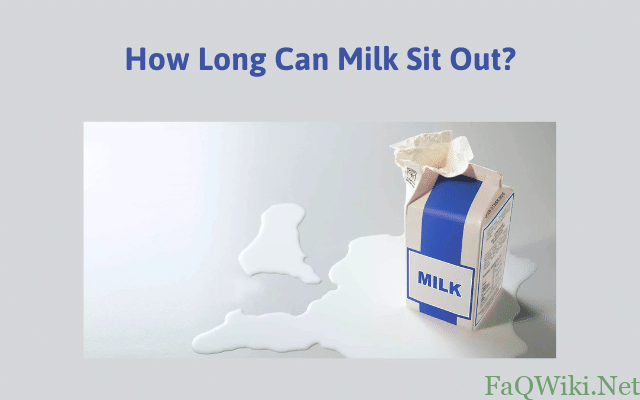How Long Can Milk Sit Out?

Milk is a staple in most households. It is consumed in various ways and is an essential ingredient in many recipes. However, have you ever wondered how long milk can sit out before it goes bad? Knowing milk’s shelf life is crucial to avoid consuming spoiled milk and getting sick. This article will explain the factors that affect milk’s shelf life, how to store milk properly, how long milk can sit out at room temperature, and what to do with spoiled milk.

Factors that Affect Milk Shelf Life
Milk’s shelf life can be affected by various factors, including:
Temperature
Milk should be stored at temperatures below 40°F (4°C) to extend its shelf life. When milk is stored at room temperature, bacteria can grow rapidly, causing it to spoil quickly.
Light Exposure
Illumination can rapidly cause milk to go bad. The UV rays in sunlight can break down the proteins in milk, causing it to spoil quickly.
Oxygen Exposure
Milk can also spoil due to exposure to air. When milk is exposed to air, it reacts with oxygen, causing it to oxidize and spoil quickly.
Microbial Growth
Bacteria are the primary cause of milk spoilage. When milk is exposed to bacteria, it can spoil within a few hours.
Packaging
The packaging of milk can also affect its shelf life. Milk stored in glass bottles can be exposed to light, causing it to spoil quickly. Additionally, milk stored in plastic bottles can absorb the flavors and odors of other foods in the fridge, affecting its taste.
Understanding Milk Shelf Life
Milk shelf life refers to the length of time milk can be stored before it becomes unsafe to consume. Milk shelf life is determined by various factors, including temperature, packaging, and processing methods.
Milk can spoil due to bacterial growth. Bacteria can grow in milk even when it is refrigerated, but the cold temperature can slow down the growth, extending milk’s shelf life. When milk starts to spoil, it can develop a sour taste, bad smell, and curdled appearance.
Types of Milk and Their Shelf Life
Different types of milk have different shelf lives. Here are some examples:
Whole Milk
Whole milk has a shelf life of approximately 5-7 days when refrigerated properly.
Skim Milk
Skim milk has a shorter shelf life than whole milk and can last for approximately 7-10 days when refrigerated properly.
Flavored Milk
Flavored milk has a shorter shelf life than unflavored milk and can last for approximately 5-7 days when refrigerated properly.
Plant-Based Milk
Plant-based milk has a longer shelf life than animal milk and can last for up to a month when refrigerated properly.
How Long Does Milk Last at Room Temperature?
For optimal safety and freshness, keep milk out of room temperature for no longer than two hours. When milk is left out at room temperature, bacteria can grow rapidly, causing it to spoil quickly. Milk that has been left out for more than 2 hours should be discarded.
How to Store Milk to Extend Its Shelf Life?
To extend milk’s shelf life, it should be stored properly. Here are some tips:
Refrigeration
Milk should be stored in the coldest part of the refrigerator, usually the back of the fridge. The temperature of the fridge should be kept below 40°F (4°C). Milk should be consumed within 5-7 days after opening.
Freezing
Milk can be frozen to extend its shelf life. It should be stored in an airtight container and labeled with the date it was frozen. Frozen milk should be consumed within 3 months
What to Do with Spoiled Milk
Spoiled milk should never be consumed as it can cause food poisoning. Instead, it should be discarded. Here are some ways to dispose of spoiled milk:
Composting
Spoiled milk can be added to compost piles. It is rich in nitrogen and can be beneficial to the composting process.
Drain Disposal
Spoiled milk can be poured down the drain. However, it is essential to run hot water down the drain afterward to prevent clogs.
Disposal in the Garbage
Spoiled milk can also be disposed of in the garbage. However, it is important to double-bag it to prevent leakage.
Conclusion
Milk is a fragile item that can spoil fast if not stored appropriately. Milk’s shelf life is affected by various factors, including temperature, light exposure, oxygen exposure, microbial growth, and packaging. Different types of milk have different shelf lives, and milk should not be left out at room temperature for more than 2 hours. To extend milk’s shelf life, it should be stored properly, either in the refrigerator or freezer. Spoiled milk should never be consumed and should be disposed of properly.
You can read more about milk here! And read more articles at FAQwiki.net!
FAQs
Q: How can I tell if milk has gone bad?
A: Spoiled milk can have a sour taste, bad smell, and curdled appearance.
Q: Can I still use milk after the sell-by date?
A: The sell-by date is a guide for retailers and not an indicator of milk’s shelf life. Milk should be consumed within 5-7 days after opening, regardless of the sell-by date.
Q: Can I freeze milk?
A: Yes, milk can be frozen to extend its shelf life. It should be stored in an airtight container and labeled with the date it was frozen. It is recommended that frozen milk be enjoyed within 3 months for optimal freshness.
Q: Can I use spoiled milk for baking?
A: No, spoiled milk should never be used for baking. It can cause food poisoning.
Q: Can I drink milk that has been left out overnight?
A: No, milk that has been left out for more than 2 hours should be discarded.
